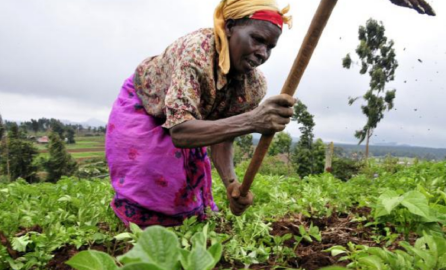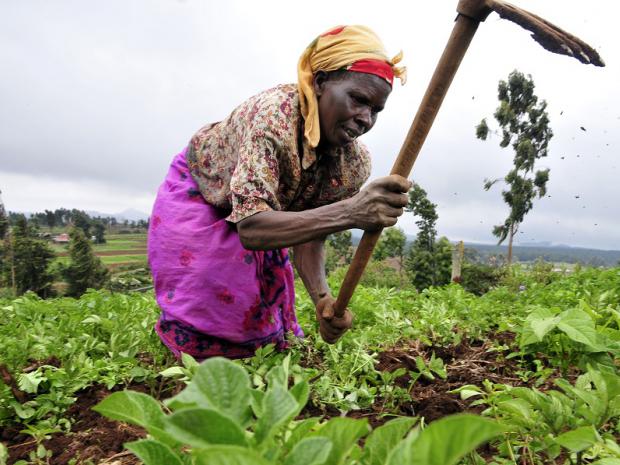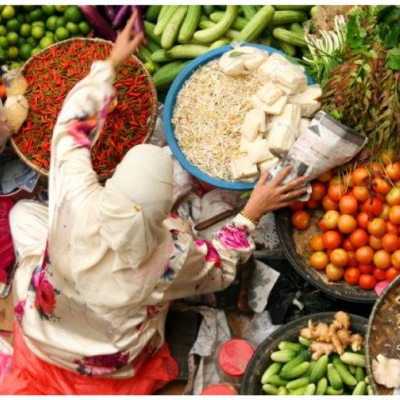“If we can replace the hand hoe with a smartphone as the most common tool in the hands of an African farmer, then we are halfway towards our dream,” said Theo de Jager, President of the Pan African Farmers Organisation and the Southern African Confederation of Agricultural Unions. That dream is to combat poverty in Africa by helping growers make the most of increasingly abundant data on prices, materials and weather.
The amount of data created through mobile phones, internet use and other digital transactions is growing exponentially. Participants at the 40th Brussels Development Briefing co-organised by CTA, DEVCO, ACP Group and Concord on Data: the next revolution for agriculture in ACP countries met recently to discuss how this so-called ‘Big Data’, including weather reports, online purchase records and GPS information, can assist farmers in developing countries.
The potential is vast but so too are the challenges, with much depending on corporations sharing the information they collect, its relevance to farmers, and new technologies’ ubiquity and ease of use.
A Kenyan farmer at work in the Mount Kenya region
The Problem
Only about a dozen countries in sub-Saharan Africa have held a census in the past ten years, and few have done household surveys, which measure things such as income, employment, health, education and nutrition.
"That's another way of saying they don't know anything about levels of productivity in their rural sector,” said Morten Jerven, Associate Professor at Simon Fraser University and author of Poor Numbers: How We Are Misled by African Development Statistics and What to Do about It.
Mr Jerven also raised doubts over the independence of official data. "Sometimes the very person who collects statistics on whether he or she is successful in delivering fertilizer is reporting on themselves."
| Morten Jerven’s article in the Journal of Agrarian Change on The Political Economy of Agricultural Statistics and Input Subsidies: Evidence from India, Nigeria and Malawi. |
Collecting agricultural statistics in many developing countries, particularly in Africa, is complicated by seasonal variations, imprecise self-reporting, and the cost and time required to measure farmland using a rope and compass, as recommended by the United Nations Food and Agriculture Organization (FAO).
Donors are also culpable, with the share of aid allocated to statistical development believed to have fallen from 0.32% in 2011 to 0.16% in 2012, (later figures for all ODA are not yet available).
The Potential
In Colombia, rice farmers may have saved $3.8 million last year after heeding the advice of data scientists not to plant crops ahead of an imminent drought predicted by new computer modelling techniques. The model developed by the International Center for Tropical Agriculture and the Colombian Rice Growers Federation used ten years’ of data on crop yield, types of crops and weather conditions to predict what would work best and where, in different weather conditions.
This is one example of the insights able to be drawn from myriad sets of information. Satellite images can read soil moisture levels by analysing infrared reflectance; GPS data can verify farmers’ self-reporting; and a recent report made the case for “weather-based” or “index” insurance for smallholders. Under this model farmers receive compensation automatically once indicators such as wind speed and rain exceed a set limit within a certain time. As a result, insurance is more affordable as the need for costly inspections (which drives up the cost of traditional indemnity insurance) is eliminated.
|
Big Data: Big Potential Imagine being able to gain information instantly about whether a development project is reaching its intended recipients, or where the next cholera outbreak might be, or track the fluctuating wealth of every district in Cote d’Ivoire. These are some of the possibilities of Big Data analysis, where data of increasing volume, velocity and variety is mined for the unprecedented patterns and insights it may yield. Revisit our Voices & Views on Big Data: Big Potential. |
Finally, there is ‘precision agriculture’, where data from sensors and satellite imagery are combined with predictive weather modelling to help farmers make real-time decisions on when to plant, fertilise and harvest crops in highly localised areas.
The Obstacles
One problem, as David Cleary from The Nature Conservancy has said, is “precision agriculture is needed most where farmers are relatively poor, yields are relatively low, population increase is relatively high, and resilience to climate change is most pressing”. At present, the benefits of these advanced technologies are enjoyed largely by farmers in developed countries.
Quantity over quality is another challenge. “We are flooded with information but not the right information,” said Pietro Gennari, Chief Statistician and Director of the FAO Statistics Division. Some information is not useful, and can even be a burden, creating confusion.
Nor does everyone have a smartphone. As Jonas Lerman wrote in Big Data and its Exclusions in the Stanford Law Review: “Billions of people worldwide remain on big data’s periphery. Their information is not regularly collected or analyzed, because they do not routinely engage in activities that big data is designed to capture.”
Services that use basic mobile phones, such as mobile banking, give telecommunication providers powerful insights into their customers. Yet "that data is not public,” said Maximo Torero, Division Director of the Markets, Trade, and Institutions Division at the International Food Policy Research Institute (IFPRI). “Normally the mobile money is handled through telecommunications companies, and those are companies that behave in a market of competition… They will never share that data because it's of huge value to them.”
|
Open Data and Smallholder Food and Nutritional Security CTA Working Paper 15/01 | February 2015 This report aims to provide a better understanding of the actual impact of the open data movement on the food and nutrition security of smallholders and highlight the areas of potential unfilled opportunity. |
The Solutions
Mr Torero argued governments should regulate to ensure potentially useful data managed by them is publicly available. He said the high price of precision farming could be addressed by investing in soil maps.
"Just to have an idea: to do a high-resolution soil map in a country like Honduras [...] it would cost you $10 million. We waste a lot more money on many other things when we can just use $10 million to develop a very high-level precision map that would allow us to have this kind of precision agriculture."
Mr Gennari reflected the view of many at the Brussels Briefing when he said that “[Big data and new technologies] need to be combined with surveys, with traditional sources of information in order to make it more cost effective, to make it more sustainable.”
One mixed model is offered by FairMatch Support, a company that helps find sustainable supply chains for companies and new markets for producers.
"Sometimes a guy going in the bush with his motorbike only has his booklet," said Herman uit de Bosch, Executive Director of FairMatch Support. But he said farmers can still note down basic data by hand, such as humidity, quality and quantity of the goods, which can then be entered into a basic spreadsheet at a computer in town.
"Maybe in three years’ time they will all have tablets, I don't know, but we will take it step-by-step. There is no logic in pushing everything at the same time."
This collaborative piece was drafted with input from Dorota Panczyk-Piqueray (DEVCO), Isolina Boto (CTA) and Morten Jerven, with support from the capacity4dev.eu Coordination Team.




Log in with your EU Login account to post or comment on the platform.